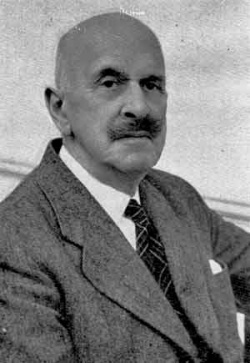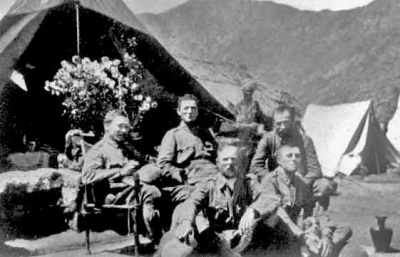Family
Norman Victor Lacey Rybot was born in Jersey on 7 January 1876, son of Colonel G O Rybot, late Bengal Artillery. As a young man he developed an absorbing interest in the island’s history, which he never lost, and joined La Société Jersiaise. He was first commissioned in August 1896, and joined the Indian Army on 19 November 1897. Posted to the 28th Punjabis, he participated in the 1903 Delhi Durbar. During that year he volunteered for Younghusband’s expedition to Tibet, taking part in the action at Niani, 26 June 1904, the subsequent operations around Gyantse, and the march to Lhassa, 14 July to 3 August 1904.
Great War
In 1914, as a Major in the 76th Punjabis, Rybot saw active service on the Suez Canal defences in Egypt. After Turkish attacks had been repelled, the 76th was transferred to Mesopotamia and landed at Basra in time for the battle of Shaiba on 12 April 1915. Following operations in Arabistan with the 30th Infantry Brigade, the column turned north-west towards the Euphrates. On the night of 13/14 July 1915, Rybot’s double company attacked Shakair and killed most of the village’s Turkish garrison. This action earned Rybot his first mention in despatches, and for his services in the subsequent operations around Nasiriya, culminating in its capture on 25th July, Rybot was awarded the Distinguished Service Order.
The British advance to capture Baghdad ground to a standstill with the four-day battle of Ctesiphon at the end of November 1915. During the battle the 76th suffered 289 casualties, including the CO killed and Rybot among the wounded. General Townshend now decided to fall back on Kut-al-Amara, the advanced base, and await relief. His weary British and Indian troops, including the 76th Punjabis, stumbled into Kut on 3 December and were immediately encircled and besieged by the Turks. Rybot’s actions during the siege, despite his wounds, earned him a second mention in despatches.
By the time Townshend surrendered to the Turks on 29 April 1916, the daily ration for British officers and men was 4 ounces of bread, usually dropped by the Royal Flying Corps, and 16 ounces of meat, normally from dead mules as the horses had long since been killed and eaten. Rybot and seven other officers and 240 men of his battalion were among the garrison that passed into captivity and the infamous ‘death march’ to Turkey. Out of the 227 officers and more than 12,000 other ranks who walked, or were carried, out of Kut, a staggering 70% died whilst in captivity. Two different accounts indicate that Rybot was left for dead about this time, but whether in Kut or in a prison camp cannot be established. Happily he recovered, and with him survived his wartime drawings which are now preserved in the Imperial War Museum, London, where they are catalogued under ‘Kut Frescoes’. During his captivity Rybot was held at several Turkish camps. In July 1916 he was at Kastamuni and then at Changri, and Afion Kara Hissar, which he left on 21 December 1917. He left the camp at Kedos in September 1918 and was finally held at Smyrna. The regimental history lists Rybot as being mentioned in despatches in 1918 for Smyrna but this cannot be traced in the London Gazette.
After his release from captivity, Rybot left the Army in December 1920 and retired to his beloved Jersey. He became secretary of the Société and resumed his studies into the history, archaeology and heraldry of the island. During the next 20 years he wrote a number of books and pamphlets and, in May 1928, he was elected a Fellow of the Society of Antiquaries of London.
Occupation stamps
When supplies of the British postage stamps ran out during the German Occupation, the Bailiff asked Rybot to submit designs for penny and halfpenny stamps. Under instruction that these stamps were not to bear the King’s head or any symbol connecting Jersey with mainland Britain, Rybot produced two trials which were closely examined by German Intelligence and duly passed for printing.
Rybot had included a few devices of his own for boosting the morale of the islanders. The heraldic beasts depicted on the stamps were the personal Arms of the Sovereign of England, given to the islanders by King Edward I in 1279. In addition, he had inserted a small capital A in each corner of the penny stamp; the four A’s stood for ‘Ad Avernum Adolf Atrox’ or, translated into English ‘To hell with you atrocious Adolf’. The upper corners of the halfpenny stamp also contained a letter A, while a small capital B appeared in the lower corners; respectively ‘Atrocious Adolf’ and ‘Bloody Benito’.
The penny stamps went on sale on 1 April 1941 and caused much amusement among the local populace. After the liberation, Major Rybot, by now a past president and Member of Honour of his Society, continued his historical research. He wrote his last book, which ran to three editions, at the age of 73. Following a fall at his home, he died in Jersey General Hospital on 18 May 1961


